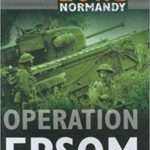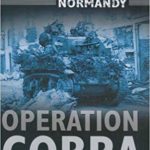Books on the Battle of Normandy
D-Day and Battle of Normandy bibliography
![]() Panzers in Normandy: Then and Now
Panzers in Normandy: Then and Now
This text explores the composition, equipment and personnel of the 1944 Panzer regiment model, focusing on the Panzer units which served in Normandy. Photographs of the battleground now and then are revealed, as is the grave of the most famous panzer commander.
by Eric Lefevre
![]() Villers Bocage
Villers Bocage
In the week after the D-Day landings, British and Canadian forces in the east were ordered to pin down as many German troops as possible to take the pressure off the Americans. This book describes the attempted capture of Villers-Bocage and Evrecy as well as Lingèvres and Les Verrières.
by George Forty
![]() Operation Goodwood
Operation Goodwood
Operation Goodwood is the story of the largest armoured battle fought in the campaign for north west Europe. Over a thousand British and Canadian tanks were employed as three British armoured divisions pushed forward down a narrow corridor in an attempt to achieve a clean penetration of the German lines. The clash between two very different armies resulted in a number of asymmetric engagements, which are studied in detail. This story contains much new information of interest to tourists and serious students alike.
by Ian Daglish
![]() Operation Epsom
Operation Epsom
Despite Monty’s claims after the war that his intention was to ‘fix’, or hold, the enemy armour in the east while the Americans swept round from the west, Epsom was clearly designed for the British to achieve the decisive breakthrough in Normandy.
by Lloyd Clark
![]() Battle for Caen
Battle for Caen
The city of Caen was perhaps the greatest major obstacle in the path of the Allied advance inland after their landings in Normandy, 6 June 1944. Consequently it was a key objective for 3rd British Division, landing on Sword Beach. The Allies were unable to capture the strategically important city on D-Day, however, in the teeth of armoured counter-attacks from 21st Panzer Division.
by Simon Trew & Stephen Badsey
![]() Operation Cobra
Operation Cobra
Operation Cobra, launched at the end of July 1944, began with a massive aerial bombardment of the German defenders, who either surrendered without a fight or fled. As American armoured divisions swept southwards and westwards, entire German units were encircled, while others simply fell apart. The war of attrition had been replaced by a war of movement.
by Christopher Pugsley
![]() Road to Falaise
Road to Falaise
By mid-July 1944, the Normandy battle had apparently degenerated into a bloody attritional war of materiel. During late July, however, Operations Cobra and Bluecoat tore the German front wide open. The Germans’ XLVII Panzer Corps hastily prepared for offensive action, but by striving for unrealistic objectives, Hitler condemned the German Army in the West to destruction by pushing it deeper into a trap.
by Simon Trew & Stephen Hart
![]() Battle for Cherbourg
Battle for Cherbourg
In order to reinforce and expand the D-Day bridgeheads won on 6 June 1944, the Allies needed a port to bring in troops and vital supplies. Cherbourg was therefore the first priority for the American VII Corps after the D-Day Landings of 6 June 1944. After establishing a firm beach-head, elements of VIII Corps, under the command of Major-General J. Lawton ‘Lightning Joe’ Collins, moved west across the base of the Cotentin Peninsula.
by Robin Havers
![]() Battle for St-Lô
Battle for St-Lô
Several elite German divisions were ordered to the St-Lo sector to counter the American threat from Carentan, captured on 12 June. By concentrating their defences twelve miles inland, these German forces halted the US advance before St-Lo, despite costly American attacks in the difficult bocage countryside. The town fell to 29th Infantry Division on 18 July, the decimated American attackers finally taking possession of its cratered landscape in which hardly a building remained standing.
by Peter Yates
![]() Villers-Bocage Through the Lens
Villers-Bocage Through the Lens
An analysis of the tank battle that took place at Villers-Bocage in 1944, when the 7th Armoured Division, or Desert Rats, took on German panzers and were heavily defeated. The text bases its arguments on photographs taken in the aftermath and the testimony of German tank ace Michael Wittmann.
by Daniel Taylor
![]() Dying for Saint-Lo: Hedgerow Hell, July 1944
Dying for Saint-Lo: Hedgerow Hell, July 1944
From 5 to 20 July 1944 American invasion forces ran into fierce resistance around the French town of Saint-Lo, an important railway and road communications center in Normandy. By going through unit logbooks, contacting veterans, and by conducting research in the field, Didier Lodieu gives us an accurate story of the Battle for Saint-Lo, illustrated with almost 300 previously unpublished photos.
by Didier Lodieu
![]() Back to the Bibliography main menu
Back to the Bibliography main menu












